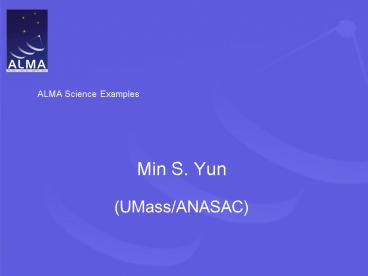ALMA Presentation - PowerPoint PPT Presentation
Title:
ALMA Presentation
Description:
... dust continuum emission from cosmologically-distant galaxies (SMGs, LBGs, EROs) ... sources and determine FIR properties of LBGs and EROs as well as SMGs ... – PowerPoint PPT presentation
Number of Views:64
Avg rating:3.0/5.0
Title: ALMA Presentation
1
ALMA Science Examples
Min S. Yun
(UMass/ANASAC)
2
ALMA Science Requirements
- High Fidelity Imaging
- Precise Imaging at 0.1 Resolution
- Routine Sub-mJy Continuum Sensitivity
- Routine mK Spectral Sensitivity
- Wideband Frequency Coverage
- Wide Field Imaging Mosaicking
- Submillimeter Receiver System
- Full Polarization Capability
- System Flexibility
3
ALMA Science Requirements
- High Fidelity Imaging
- Imaging spatial structures within galactic disks
- Imaging chemical structure within molecular
clouds - Imaging protostars in star formation regions
- Precise Imaging at 0.1 Resolution
- Ability to discriminate galaxies in deep images
- Imaging tidal gaps created by protoplanets around
protostars - Imaging nuclear kinematics
- Routine Sub-mJy Continuum Sensitivity
- To enable imaging of the dust continuum emission
from cosmologically-distant galaxies (SMGs, LBGs,
EROs) - To enable imaging of protostars throughout the
Milky Way - To enable astrometric observations of solar
system minor planets and Kuiper-belt objects
4
M51 in Ha
5
Simulated Protoplanetary Disk
Credit L. Mundy
6
ALMA Science Requirements
- Routine mK Spectral Sensitivity
- Spectroscopic probes of protostellar kinematics
- chemical analysis of protostars, protoplanetary
systems and galactic nuclei - Spectroscopic studies of galactic disks and
spiral structure kinematics - Spectroscopic studies of Solar System objects
- Wideband Frequency Coverage
- Spectroscopic imaging of redshifted lines from
cosmologically distant galaxies - comparative astrochemical studies of protostars,
protoplanetary disks and molecular clouds - quantitative astrophysics of gas temperature,
density and excitation - Wide Field Imaging Mosaicking
- Imaging galactic disks
- Imaging the astrophysical context of star
formation regions - Imaging surveys of large angular regions
- Imaging planetary surfaces
- Solar astrophysics
7
Forests of Spectral Lines
Schilke et al. (2000)
8
Physics of Interstellar Medium
Credit M. Heyer
9
ALMA Science Requirements
- Submillimeter Receiver System
- Spectral energy distribution of high redshift
galaxies - Chemical spectroscopy using C I and atomic
hydrides - C II and N II abundance as a function of
cosmological epoch - Chemistry of protoplanetary systems
- Full Polarization Capability
- Measurement of the magnetic field direction from
polarized emission of dust - Measurement of the magnetic field strength from
molecular Zeeman effect observations - Measurement of the magnetic field structure in
solar active regions - System Flexibility
- To enable VLBI observations
- To enable pulsar observations
- For differential astrometry
- For solar astronomy
10
C II Emission from High-z Galaxies
Credit K. Menten
11
VLBI Imaging of SgrA
Falke et al. (2000)
12
Summary of detailed requirements
13
ALMA Design Reference Science Plan(DRSP)
- Goal To provide a prototype suite of
high-priority ALMA projects that could be carried
out in 3 yr of full ALMA operations - Started planning late April 2003 outline teams
complete early July submitted December 2003 - 128 submissions received involving 75
astronomers - Review by ASAC members completed comments
included - Current version of DRSP on Website at
- http//www.strw.leidenuniv.nl/joergens/alma
14
Example ALMA Deep Field
Step 1 300 GHz Continuum Survey
- 4 x 4 Field ( 3000x3000 pixels)
- Sensitivity 0.1 mJy (5s)
- 30 minutes per field
- 140 pointings
- A total of 3 days
- 100-300 sources
Determine the contribution of LBGs to the IR
background
15
Infrared Luminous Galaxies
M82 from ISO, Beelen and Cox, in preparation
- As galaxies get redshifted into the ALMA bands,
dimming due to distance is offset by the brighter
part of the spectrum being redshifted in. Hence,
galaxies remain at relatively similar brightness
out to high distances.
16
Hubble Deep Field Rich in Nearby Galaxies, Poor
in Distant Galaxies
Source K. Lanzetta, SUNY-SB
Nearby galaxies in HDF
Distant galaxies in HDF
17
ALMA Deep FieldPoor in Nearby Galaxies, Rich in
Distant Galaxies
Source Wootten and Gallimore, NRAO
Nearby galaxies in ALMA Deep Field
Distant galaxies in ALMA Deep Field
18
Example ALMA Deep Field
Step 2 100 GHz Spectroscopic Survey
- 4 x 4 Field ( 1000x1000 pixels)
- Sensitivity 7.5 mJy continuum and 0.02 Jy km/s
for a 300 km/s line (5s) - 12 hrs per field
- 16 pointings (a total of 8 days)
- 4 tunings
- One CO line for all sources at z2 and two or
more at z6 - Photometric redshifts
Obtain spectroscopic redshifts
19
Example ALMA Deep Field
Step 3 200 GHz Spectroscopic Survey
- 4 x 4 Field ( 2000x2000 pixels)
- Sensitivity 50 mJy continuum (5s)
- 1.5 hrs per field
- 90 pointings (a total of 6 days)
- 8 tunings
- Along with Step 2, at least one CO line for all
redshifts, two CO lines at z2 - Photometric redshifts
20
Gas Distribution and Kinematics
Chapman et al. (2004)
21
Summary ALMA Deep Field
- Fully resolve the cosmic IR background into
individual sources and determine FIR properties
of LBGs and EROs as well as SMGs - Quantify the properties of high-z dusty galaxies
(SFRs, gas content, dynamical mass, etc.) - Map the cosmic evolution of dusty galaxies and
their contribution to the cosmic star formation
history































